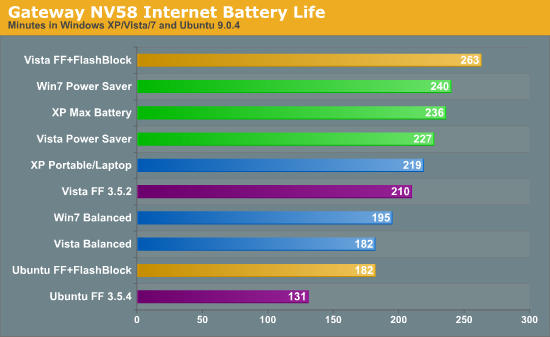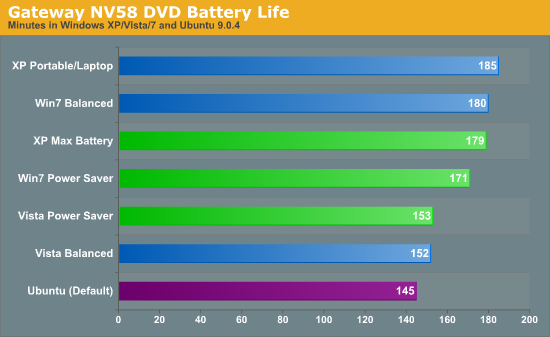Gateway NV58 (Intel) - Battery Life
We first looked at AMD's mobile platform with several operating systems and now it's Intel's turn. Once again, here's the rundown of specifications followed by the results, starting with battery life.
| Gateway NV5807u Test System | |
| Processor | Intel Core 2 Duo T6500 (Dual-core, 2.1GHz, 2MB shared L2, 45nm, 35W, 800MHz FSB) |
| Memory | 2x2048MB Micron PC2-5300 @ DDR2-667 5-5-5-15 (Micron Technologies 16HTF25664HY-667G1) |
| Graphics | Integrated Intel GMA 4500MHD Driver version 15.13.4.64.1829 10 Shaders at 475 MHz |
| Display | 15.6" Glossy WXGA (1366x768) LG LP156WH2-TLE1 |
| Hard Drive | HITACHI Travelstar 5K500.B 320GB 5400RPM 8MB (HTS545032B9A300) |
| Optical Drive | 8x DVDRW (TSST Corp TS-L633B) |
| Battery | 6-Cell 10.8V, 4400mAhr, 47.5Whr |
| Operating System | Windows Vista Home Premium 64-bit |
| Price | NV5814u available online starting at $580 |


If you expected the standings to remain the same regardless of computer hardware, you might be in for a bit of a surprise by the above charts. This time, Windows XP wins in both DVD playback results, providing better battery life using the "Portable" profile than the "Max Battery" profile. Windows 7 also performs slightly better on DVD playback using the Balanced profile, whereas we saw virtually no difference between the power profiles using the NV52.
Why is Balanced beating Power Saver this time? Intel's SpeedStep technology appears to be better than AMD's PowerNow!, though minor differences in drivers may also contribute to the standings. The theory is that letting your CPU run at 100% for a short time and then returning to minimum power draw as fast as possible results in the best battery life, which is why setting the maximum CPU state to 50% isn't always the best idea. Intel CPUs are supposed to switch between C-states faster than AMD CPUs, or so we've heard, and these results seem to support that idea. However, the Internet battery tests again all favor the power saving profiles by a large margin, so power saving profiles can have a positive impact, just not in DVD playback. Ubuntu brings up the rear in both battery life tests once again.
Internet battery life shows different standings on the three Windows operating systems compared to the NV52. Windows 7 is just 2% ahead of XP and 6% ahead of Vista with the power saving profile; switch to the balanced profile and XP jumps into the lead offering 12% more battery life than Windows 7 and 20% more battery life than Vista. Looking at the profiles, Windows XP shows the smallest change by using a power saving profile, improving by 8% when using the Max Battery option. Windows 7 and Vista both improve by around 25% (23% for Windows 7). That means all three Windows OSes did better in Internet battery life with power saving profiles relative to the NV52.
Our testing with Ubuntu once again requires a bit of explanation. First, LCD brightness adjustment did not work properly under Ubuntu (with the drivers we used), with the final setting ending up at 150 nits instead of 100 nits. That means battery life is going to be slightly lower because the LCD is consuming an extra 1-2W. Second, unlike the NV52, we didn't experience any difficulties with DVD playback - hooray! Internet performance using Firefox still feels horribly slow in comparison to Firefox or Internet Explorer on Windows, and while blocking Flash content helps we still prefer Windows.
Enabling FlashBlock with Firefox again has a substantial impact on battery life; Vista improves by 25% - the same as on the NV52 - and Ubuntu improves by 39% - slightly less of an improvement compared to the NV52. The gap between Vista and Ubuntu is still huge, even bigger than on the NV52. Without FlashBlock, Firefox on Vista offers 60% more battery life than Firefox on Ubuntu. Even with FlashBlock, the gap remains at 45%, which is far more than the Power Saver profile offers.
Overall, Windows XP leads in best-case battery life for DVD playback on the Intel platform, providing 3% more battery life than Windows 7 - not a huge difference. The gap between Windows 7 and Vista is much larger, with the best-case Windows 7 result being 18% higher than the Windows Vista scores. Ubuntu almost matches Windows Vista, and it might even match Vista if we could modify the LCD brightness.










106 Comments
View All Comments
PrinceGaz - Tuesday, September 22, 2009 - link
When surfing on my iTouch, I find that the vast majority of websites display almost the same (complete with images) despite the lack of Flash, and Java as well for that matter (it does at least support JS). There are just the odd undisplayed areas which in most cases are where I know ads would be normally. A very few websites use Flash for navigation and content display without any alternative version of the site available, but the overwhelming majority of sites display fine.That being said, I would prefer to have the option to enable Flash and/or Java if I wished, but would probably leave Flash off most of the time given the likely impact it would have on battery-life and overall responsiveness.
strikeback03 - Tuesday, September 22, 2009 - link
Is there a way to force a mobile version of ESPN that still displays all the links that are flash on the main site?emboss - Tuesday, September 22, 2009 - link
For day-to-day browsing I have flash turned off. Even on Windows it speeds things up, and as a bonus kills most of the ads that try and get around ad blocking. Excluding YouTube videos, I maybe have to enable it once a month or so to use a site that's broken enough to require it.Then again, I use the internet for information rather than entertainment, and things like MSDN don't require flash :)
sc3252 - Tuesday, September 22, 2009 - link
Flash isnt really a part, you can view most sites without it. The only sites that really need it are those crapy sites you really dont want to be at.Another nice point to make is how poorly optimized flash is for GNU/Linux. I am not surprised when using firefox without blocking flash you get such lower battery life since there is almost no acceleration on GNU/Linux. With a 3.2ghz core 2 I can't watch fullscreen flash without skipping and jerking on Debian testing.
pcfxer - Tuesday, September 22, 2009 - link
With my 2.9GHz Athlon X2 5000+ BE, 4GB RAM on PC-BSD 64-bit (with the stock nvidia drivers), I am able to view full screen HD flash without a hint of trouble. This is handled via binary emulation of Linux running Firefox linux with linux flash plugins.Perhaps, anand could test a REAL Unix-like OS and try out PC-BSD. It is MORE "free" than Linux (GPL).
pcfxer - Tuesday, September 22, 2009 - link
I realize that some people may mistake this "REAL Unix-like" for seriousness, it is a joke btw. That said, I am serious about testing PC-BSD - I am a tester for them anyhow ;).